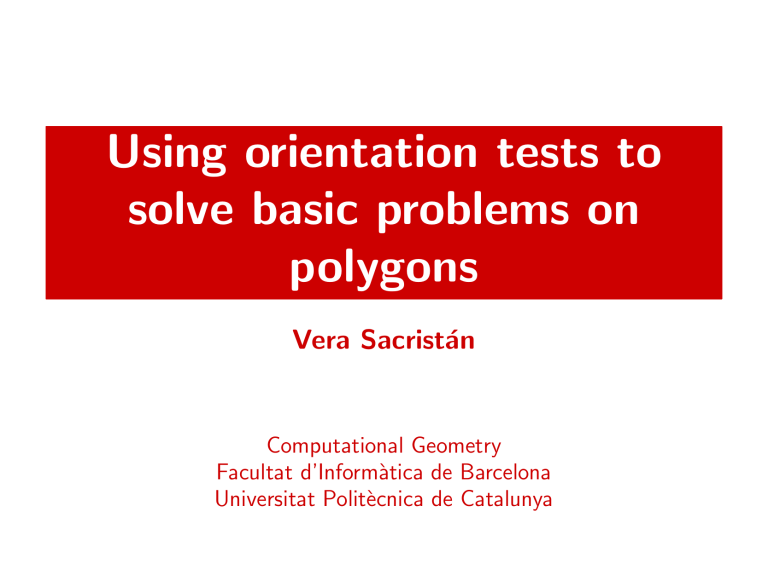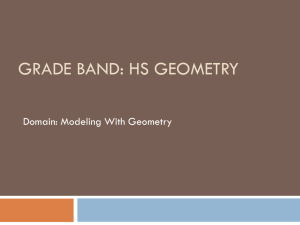
Using orientation tests to solve basic problems on polygons Vera Sacristán Computational Geometry Facultat d’Informàtica de Barcelona Universitat Politècnica de Catalunya USING ORIENTATION TESTS ON POLYGONS Intersection test line - polygon Input: `: a line (through p and q) P : a polygon (with vertices p1 , p2 , . . . , pm ) Yes/No they intersect. If they do, the edges of P intersecting ` Computational Geometry, Facultat d’Informàtica de Barcelona, UPC USING ORIENTATION TESTS ON POLYGONS Intersection test line - polygon Input: `: a line (through p and q) P : a polygon (with vertices p1 , p2 , . . . , pm ) Yes/No they intersect. If they do, the edges of P intersecting ` What if the polygon is convex? Computational Geometry, Facultat d’Informàtica de Barcelona, UPC USING ORIENTATION TESTS ON POLYGONS Point in polygon test Input: A polygon p1 , p2 , . . . , pn A query point q Output: Yes/No q ∈ P Computational Geometry, Facultat d’Informàtica de Barcelona, UPC USING ORIENTATION TESTS ON POLYGONS Point in polygon test Input: A polygon p1 , p2 , . . . , pn A query point q Output: Yes/No q ∈ P What if the polygon is convex? Computational Geometry, Facultat d’Informàtica de Barcelona, UPC USING ORIENTATION TESTS ON POLYGONS Supporting lines point - polygon Input: A polygon P with vertices p1 , p2 , . . . , pn A point q not belonging to the convex hull of P Output: Lines through q and P that leave all of P to one side P q Computational Geometry, Facultat d’Informàtica de Barcelona, UPC USING ORIENTATION TESTS ON POLYGONS Supporting lines point - polygon Input: A polygon P with vertices p1 , p2 , . . . , pn A point q not belonging to the convex hull of P Output: Lines through q and P that leave all of P to one side P q Computational Geometry, Facultat d’Informàtica de Barcelona, UPC USING ORIENTATION TESTS ON POLYGONS Supporting lines point - polygon Input: A polygon P with vertices p1 , p2 , . . . , pn A point q not belonging to the convex hull of P Output: Lines through q and P that leave all of P to one side What if the polygon is convex? P q Computational Geometry, Facultat d’Informàtica de Barcelona, UPC USING ORIENTATION TESTS ON POLYGONS How did we prove the correctness of our solutions? Computational Geometry, Facultat d’Informàtica de Barcelona, UPC USING ORIENTATION TESTS ON POLYGONS How did we prove the correctness of our solutions? P q Computational Geometry, Facultat d’Informàtica de Barcelona, UPC USING ORIENTATION TESTS ON POLYGONS How did we prove the correctness of our solutions? P q Geometric property: No particular one. Computational Geometry, Facultat d’Informàtica de Barcelona, UPC USING ORIENTATION TESTS ON POLYGONS How did we prove the correctness of our solutions? P q Geometric property: No particular one. Brute-force solution O(n) time O(n) space Computational Geometry, Facultat d’Informàtica de Barcelona, UPC USING ORIENTATION TESTS ON POLYGONS How did we prove the correctness of our solutions? P q Geometric property: No particular one. Geometric property: p ∈ P ⇔ The number of intersections of ∂P and any halfline with origin at p is odd. Brute-force solution O(n) time O(n) space Computational Geometry, Facultat d’Informàtica de Barcelona, UPC USING ORIENTATION TESTS ON POLYGONS How did we prove the correctness of our solutions? P q Geometric property: No particular one. Geometric property: p ∈ P ⇔ The number of intersections of ∂P and any halfline with origin at p is odd. Brute-force solution Brute-force solution O(n) time O(n) space O(n) time O(n) space Computational Geometry, Facultat d’Informàtica de Barcelona, UPC USING ORIENTATION TESTS ON POLYGONS How did we prove the correctness of our solutions? P q Geometric property: No particular one. Geometric property: p ∈ P ⇔ The number of intersections of ∂P and any halfline with origin at p is odd. Brute-force solution Brute-force solution O(n) time O(n) space Geometric property: The solutions are the angularly extreme vertices of P as seen from p. O(n) time O(n) space Computational Geometry, Facultat d’Informàtica de Barcelona, UPC USING ORIENTATION TESTS ON POLYGONS How did we prove the correctness of our solutions? P q Geometric property: No particular one. Geometric property: p ∈ P ⇔ The number of intersections of ∂P and any halfline with origin at p is odd. Geometric property: The solutions are the angularly extreme vertices of P as seen from p. Brute-force solution Brute-force solution Use a max/min algorithm O(n) time O(n) space O(n) time O(n) space Computational Geometry, Facultat d’Informàtica de Barcelona, UPC O(n) time O(n) space USING ORIENTATION TESTS ON POLYGONS How did we prove the correctness of our solutions? P q Computational Geometry, Facultat d’Informàtica de Barcelona, UPC USING ORIENTATION TESTS ON POLYGONS How did we prove the correctness of our solutions? P q Geometric property: Distance to line is unimodal along each chain of ∂P . Computational Geometry, Facultat d’Informàtica de Barcelona, UPC USING ORIENTATION TESTS ON POLYGONS How did we prove the correctness of our solutions? P q Geometric property: Distance to line is unimodal along each chain of ∂P . Binary search solution O(log n) time O(n) space (after preprocess) Computational Geometry, Facultat d’Informàtica de Barcelona, UPC USING ORIENTATION TESTS ON POLYGONS How did we prove the correctness of our solutions? P q Geometric property: Distance to line is unimodal along each chain of ∂P . Geometric property: Segments connecting two vertices decompose P into two convex subpolygons. Binary search solution O(log n) time O(n) space (after preprocess) Computational Geometry, Facultat d’Informàtica de Barcelona, UPC USING ORIENTATION TESTS ON POLYGONS How did we prove the correctness of our solutions? P q Geometric property: Distance to line is unimodal along each chain of ∂P . Geometric property: Segments connecting two vertices decompose P into two convex subpolygons. Binary search solution Binary search solution O(log n) time O(n) space (after preprocess) O(log n) time O(n) space (after preprocess) Computational Geometry, Facultat d’Informàtica de Barcelona, UPC USING ORIENTATION TESTS ON POLYGONS How did we prove the correctness of our solutions? P q Geometric property: Distance to line is unimodal along each chain of ∂P . Geometric property: Segments connecting two vertices decompose P into two convex subpolygons. Binary search solution Binary search solution O(log n) time O(n) space (after preprocess) O(log n) time O(n) space (after preprocess) Geometric property: Angle wrt q is unimodal along ∂P . Computational Geometry, Facultat d’Informàtica de Barcelona, UPC USING ORIENTATION TESTS ON POLYGONS How did we prove the correctness of our solutions? P q Geometric property: Distance to line is unimodal along each chain of ∂P . Geometric property: Segments connecting two vertices decompose P into two convex subpolygons. Geometric property: Angle wrt q is unimodal along ∂P . Binary search solution Binary search solution Binary search solution O(log n) time O(n) space (after preprocess) O(log n) time O(n) space (after preprocess) O(log n) time O(n) space (after preprocess) Computational Geometry, Facultat d’Informàtica de Barcelona, UPC USING ORIENTATION TESTS ON POLYGONS FURTHER READING J. O’Rourke Computational Geometry in C Cambridge University Press, 1994 (2nd ed. 1998), pp. 17-35. F. P. Preparata and M. I. Shamos Computational Geometry: An Introduction Springer-Verlag, 1985, pp. 36-45. Computational Geometry, Facultat d’Informàtica de Barcelona, UPC
